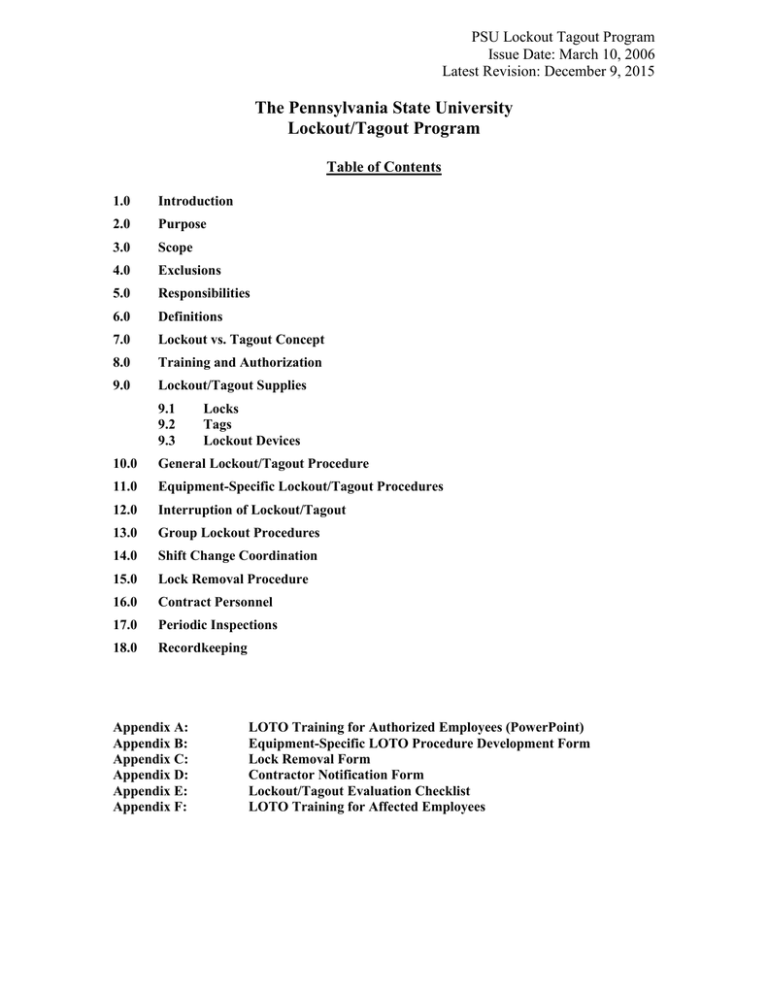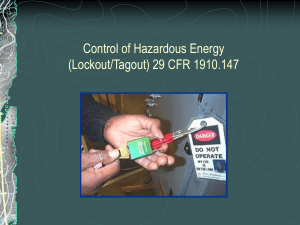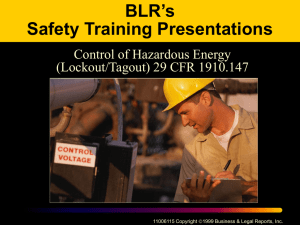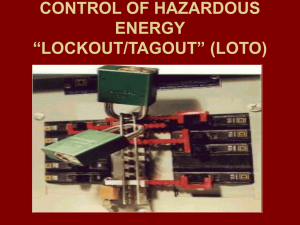The Pennsylvania State University Lockout/Tagout Program PSU Lockout Tagout Program
advertisement

PSU Lockout Tagout Program Issue Date: March 10, 2006 Latest Revision: December 9, 2015 The Pennsylvania State University Lockout/Tagout Program Table of Contents 1.0 Introduction 2.0 Purpose 3.0 Scope 4.0 Exclusions 5.0 Responsibilities 6.0 Definitions 7.0 Lockout vs. Tagout Concept 8.0 Training and Authorization 9.0 Lockout/Tagout Supplies 9.1 9.2 9.3 Locks Tags Lockout Devices 10.0 General Lockout/Tagout Procedure 11.0 Equipment-Specific Lockout/Tagout Procedures 12.0 Interruption of Lockout/Tagout 13.0 Group Lockout Procedures 14.0 Shift Change Coordination 15.0 Lock Removal Procedure 16.0 Contract Personnel 17.0 Periodic Inspections 18.0 Recordkeeping Appendix A: Appendix B: Appendix C: Appendix D: Appendix E: Appendix F: LOTO Training for Authorized Employees (PowerPoint) Equipment-Specific LOTO Procedure Development Form Lock Removal Form Contractor Notification Form Lockout/Tagout Evaluation Checklist LOTO Training for Affected Employees PSU LOTO Program Issue Date: March 10, 2006 Latest Revision: December 9, 2015 1.0 Introduction: It is the policy of the Pennsylvania State University (PSU) to prevent a hazardous release of energy during all servicing, maintenance, and modification of equipment. This policy is implemented through the use of the Lockout/Tagout (LOTO) procedures described in this document. These procedures must be followed when it is necessary to service any equipment that may release any form of hazardous energy. The control of hazardous energy will be accomplished by locking and tagging out energy isolation devices and otherwise disabling equipment. All sources of hazardous energy must be controlled during the servicing of equipment. Examples of such energy include electrical, hydraulic, pneumatic, thermal, chemical, suspended parts, and any other form of energy that presents a hazard. 2.0 Purpose: The purpose of this program is to establish procedures to protect employees from injury during the servicing of equipment by preventing unexpected energization. This program has been developed in accordance with the provisions of OSHA standard 29 CFR 1910.147, “Control of Hazardous Energy”. 3.0 Scope: This program applies to employees and students at all PSU locations, except for the Hershey Medical Center and the College of Medicine. 4.0 Exclusions: 4.1 Normal production operations are not covered by this program if they are routine, repetitive, and integral to the use of the equipment for production purposes provided that the work is performed using alternative measures that provide effective protection. Examples of alternative measures that might offer effective protection would include light curtains, sensing devices, safety interlocks, or the use of extension tools. Normal production operations are covered by this program if one of the following conditions exists: 4.1.1 An employee is required to remove or bypass a guard or other safety device; or 4.1.2 An employee is required to place any part of his or her body into an area on a machine or piece of equipment where work is actually performed upon the material being processed (point of operation) or where an associated danger zone exists during a machine operation cycle. 4.2 Work on cord and plug-connected equipment is not covered by this program if unplugging the equipment controls all energy and the plug remains under the continuous control of the employee performing the service work. 4.3 Hot tap operations involving transmission and distribution systems are not covered by this program if the supervisor of the work demonstrates that (1) Page 2 of 10 PSU LOTO Program Issue Date: March 10, 2006 Latest Revision: December 9, 2015 continuity of service is essential, (2) shutdown of the system is impractical, and (3) documented procedures offering effective protection are followed. 5.0 Responsibilities: 5.1 Budget Executives and Budget Administrators Ensure that responsibilities assigned within this program are carried out within their administrative work unit. Monitor implementation of this program within their work unit. Ensure adequate funding is available to support this program. 5.2 Environmental Health & Safety Department Assist work units in implementing the provisions of this program. Develop training materials related to this program. Assist in providing general LOTO training to employees. Maintain records in accordance with Section 18.2 of this document. Periodically audit and update the LOTO program as needed. 5.3 Unit Safety Officers Coordinate implementation of the LOTO program within the work unit. Ensure equipment-specific LOTO procedures are developed within the work unit. Ensure required training is provided to employees within the work unit. Assist in the investigation of all injuries and incidents involving LOTO. Ensure that the records outlined in Section 18.1 of this document are maintained for their work unit. 5.4 Supervisors Be thoroughly informed of the contents of this program and how it applies to their areas of responsibility and authority. Ensure employees comply with all provisions of the LOTO program. Identify all authorized employees under their supervision. Ensure authorized employees receive general LOTO training and affected employees receive Affected Employee Training. Provide training to employees on equipment-specific LOTO procedures within the work unit. Investigate all injuries and incidents involving LOTO. Ensure that employees are provided with sufficient locks, tags, and lockout devices. Complete annual LOTO inspections in accordance with Section 17.0 of this document. Take prompt corrective action when unsafe LOTO conditions or practices are observed. 5.5 Employees Comply with all provisions of the LOTO program. Attend LOTO training sessions as required. Promptly report any concerns related to LOTO to their immediate supervisor. Page 3 of 10 PSU LOTO Program Issue Date: March 10, 2006 Latest Revision: December 9, 2015 6.0 Definitions: The following terms are defined in order to allow a better understanding of this program: 7.0 Affected employee: An employee who is responsible for the operation of equipment on which servicing is being completed under LOTO conditions. Authorized employee: An employee approved to lock and tag out equipment in order to complete servicing on that equipment. An “authorized employee” and an “affected employee” may be the same person when the affected employee’s duties include equipment maintenance or repair. Capable of being locked out: An energy isolation device is capable of being locked out if (1) it is designed with a hasp or other means of attachment to which a lock can be affixed; or (2) it has a locking mechanism built into it. Energized: Connected to an energy source or containing residual or stored energy. Energy isolation device: A mechanical device that physically prevents transmission of energy. Examples of energy isolation devices would include the following: a manually operated circuit breaker; an electrical disconnect switch; a line valve; and similar devices used to block or isolate energy. (Note: Push buttons, selector switches, and other control-circuit devices are not energy isolation devices). Energy source: Any source of electrical, mechanical, hydraulic, pneumatic, chemical, thermal, or other energy. Lockout: The placement of a lockout device on an energy isolating device which ensures that the energy isolation device and the equipment being controlled cannot be operated until the lockout device is removed. Lockout device: A device that utilizes a lock and key to hold an energy isolation device in the “SAFE” or “OFF” position and prevents machinery or equipment from becoming energized. LOTO: An acronym for “Lockout/Tagout”. Other employee: An employee who is not directly responsible for the operation of equipment which is being serviced under LOTO conditions, but who is present in the immediate area of the servicing. Servicing or service work: Workplace activities such as constructing, installing, setting up, adjusting, inspecting, modifying, and maintaining machines or equipment. Tagout: The placement of a tagout device on an energy isolation device to indicate that the energy isolation device and the equipment being controlled may not be operated until the tagout device is removed. Tagout Device: A prominent warning device, such as a tag and a means of attachment, which can be securely attached to equipment for the purpose of alerting personnel not to operate an energy isolation device. Tagout devices are used to identify the authorized employee responsible for the servicing and the date of application. Lockout vs. Tagout Concept: 7.1 During the servicing of equipment, each energy isolation device that is “capable of being locked out” will have both a lock and a tag attached to it. Lockout in combination with tagout is the preferred method of energy isolation at PSU. 7.2 If an energy isolation device will not accept a lock, this is a “tagout” situation and tags alone should be securely attached to each isolation point. Tags are to be Page 4 of 10 PSU LOTO Program Issue Date: March 10, 2006 Latest Revision: December 9, 2015 treated with the same respect as locks. They may never be bypassed or ignored and may only be removed by the employee who applied them. 8.0 9.0 Training and Authorization: 8.1 The level of LOTO training provided to employees is based on their level of involvement with LOTO procedures. 8.2 Each work unit is responsible for maintaining a master list of all authorized employees. 8.3 “Authorized employees” will be trained in the purpose and use of LOTO procedures, the recognition of hazardous energy sources, the types and magnitude of hazardous energy sources expected to be encountered, and the methods that are necessary for proper energy isolation and control. 8.4 “Affected employees” and “other employees” will be trained in the purpose of LOTO procedures. They will also be shown samples of the locks and tags used during LOTO procedures. They will be instructed not to remove locks or tags for any reason nor to attempt to energize equipment that is being serviced. Appendix F can be used to provide this training. 8.5 EHS is available to assist work units in providing general LOTO training to their employees. 8.6 Supervisors are responsible for training their employees on equipment-specific LOTO procedures. 8.7 Retraining will be provided to employees whenever there is a change in job assignments, processes, or equipment that creates a new hazard. Retraining will also be provided whenever there is a change in LOTO procedures. 8.8 Work units are responsible for maintaining a record of all LOTO training provided to their employees. EHS will maintain records of LOTO training provided by EHS personnel. 8.9 General LOTO training materials have been developed by EHS and are available in Appendix A of this document. Lockout/Tagout Supplies: 9.1 Locks 9.1.1 Work units are responsible for ensuring that an adequate supply of locks is available to authorized employees. 9.1.2 A Master Lock “Pro Series 6835” lock with a red body and a vertical shackle clearance of three inches is the only type of lock to be used for LOTO purposes at PSU. This lock may not be used for any other purpose (such as securing toolboxes or lockers). Page 5 of 10 PSU LOTO Program Issue Date: March 10, 2006 Latest Revision: December 9, 2015 9.2 9.3 10.0 9.1.3 All locks shall be individually numbered and keyed. If duplicate keys exist for the same lock, an effective system must be established for management of the keys. 9.1.4 Locks and keys are for the exclusive use of the holder and may not be loaned to other employees for any reason. Tags 9.2.1 Tags are to be used in conjunction with all locks. 9.2.2 Work units are responsible for ensuring that an adequate supply of tags is available to authorized employees. 9.2.3 All tags must legibly indicate the user name and date of application. 9.2.4 All tags must be securely attached. Use of a locking nylon cable tie is the preferred means of attachment for tags. 9.2.5 Tags must be capable of withstanding the environmental conditions to which they are exposed. Lockout Devices 9.3.1 Lockout devices include such items as multiple lockout hasps, valve enclosures, circuit breaker lockouts, chains, plug enclosures, and other devices of this nature. 9.3.2 Work units are responsible for ensuring that an adequate supply of lockout devices appropriate for the tasks encountered is made available to authorized employees. 9.3.3 Lockout devices must always be secured with a lock. General Lockout/Tagout Procedure: The following general steps will be taken by PSU employees when locking and tagging out equipment: 10.1 Identify All Energy Sources: All electrical, hydraulic, pneumatic, and other energy sources feeding the equipment must be identified. Any questionable identification of energy sources should be clarified with supervision prior to beginning any service work. 10.2 Notify Others: The authorized employee completing the servicing must verbally notify all “affected” and “other” employees of the impending equipment shutdown. 10.3 Shutdown Equipment: If the equipment is running, it must be shutdown using the normal stopping procedures. (Example: Depress “stop” button, open toggle switch, etc.) Page 6 of 10 PSU LOTO Program Issue Date: March 10, 2006 Latest Revision: December 9, 2015 11.0 10.4 Isolate Equipment from Energy Sources: Once the equipment has been shut down, all energy isolation devices must be operated so that the equipment is disconnected from its energy sources. (Example: Turn electrical disconnects to “Off” or “Safe” position; open electrical circuit breakers; close hydraulic valves; close pneumatic valves, etc.) 10.5 Lockout/Tagout the Equipment: Locks and lockout devices must be attached to each energy isolation device in order to prevent the transmission of energy. A tag indicating the lock holder and the date of application must accompany each lock. A tag should also be placed near the equipment’s point of operation if it is located remotely from the energy isolation device(s). 10.6 Release or Block Stored Energy: After the equipment has been isolated and locked/tagged out, all stored energy must be safely controlled. The appropriate bleeding or blocking methods must be used to dissipate stored energy sources (such as hydraulic pressure, pneumatic pressure, steam pressure, suspended parts, spring-driven parts, etc.). 10.7 Verify Isolation of Equipment: Prior to beginning any service work, the authorized employee must attempt to restart the equipment using the normal starting procedure or otherwise ensure the effectiveness of the lockout. Operational controls must be returned to the “Off” position after a restart attempt has been completed. 10.8 Perform Required Servicing: During the completion of service work, employees must avoid doing anything that could potentially reactivate the equipment. 10.9 Release from Lockout/Tagout: All locks, lockout devices, and tags must be removed by the same person who applied each item. Prior to restarting equipment, all tools must be removed from the work area and all machine guards must be in place. All “affected” and “other” employees must be verbally informed of the restart and cleared from the equipment area prior to energization. Equipment-Specific Lockout/Tagout Procedures: 11.1 Each work unit is responsible for developing specific LOTO procedures for equipment serviced by their personnel. 11.2 Appendix B can be used to develop equipment-specific LOTO procedures. 11.3 Equipment-specific procedures shall identify the information that an authorized employee must know in order to effectively control hazardous energy sources. If this information is the same for various machines or equipment or if another means of logical grouping exists, then a single energy control procedure may be sufficient. EHS should be consulted when making the determination as to whether procedures can be grouped in this manner. 11.4 Records of equipment-specific LOTO procedures will be maintained by each work unit and will be available for review by EHS. Page 7 of 10 PSU LOTO Program Issue Date: March 10, 2006 Latest Revision: December 9, 2015 12.0 Interruption of Lockout/Tagout: 12.1 The following sequence of actions must be taken when equipment being serviced under LOTO conditions must be energized for testing or positioning: 12.2 13.0 14.0 Clear the equipment of all tools and materials. Clear personnel from the equipment area. Remove any repositioning or blocking devices. Remove locks and lockout devices from energy isolation devices. Energize equipment and proceed with testing or positioning. The equipment must be de-energized and locked/tagged out in accordance with Section 10.0 of this document if servicing is to continue after testing or positioning has been completed. Group Lockout Procedures: 13.1 When more than one authorized employee is servicing a single piece of equipment, each employee must have their own lock and tag secured to each energy isolation device. This can be accomplished by utilizing a hasp designed to accept multiple locks. 13.2 During group lockouts, one group member shall be assigned responsibility for ensuring that all steps of the general LOTO procedure described in Section 10.0 are followed. This person shall attach a hasp to each energy isolation device. All employees involved in the servicing must then attach their own locks and tags to each hasp. 13.3 Employees shall remove their own locks and tags after they have completed their portion of the work. The group member referenced in Section 13.2 shall always remove their locks and tags last. Once this has been done, this same person is then responsible for ensuring the equipment is energized in accordance with Section 10.9. 13.4 Alternative group lockout procedures must be approved by EHS. Such procedures must afford all employees a level of protection equivalent to that provided by a personal lockout or tagout device. Shift Change Coordination: 14.1 LOTO protection must not be interrupted when servicing lasts longer than one shift. 14.2 If the equipment is the sole responsibility of authorized employees on a single shift, locks and tags shall be left in place until the servicing is complete. 14.3 If it is necessary for servicing to continue into the next shift, the oncoming employee shall attach their locks and tags to each energy isolation device prior to the outgoing employee removing their locks and tags. Page 8 of 10 PSU LOTO Program Issue Date: March 10, 2006 Latest Revision: December 9, 2015 14.4 15.0 Alternative shift change procedures must be approved by EHS. Such procedures must ensure continuity of LOTO protection for all employees. Lock Removal Procedure: 15.1 If it becomes necessary to remove a lock when the owner is not available, the lock owner’s supervisor must be notified. 15.2 The supervisor may remove a lock ONLY after each of the following steps has been taken: 1. 2. 3. 4. It has been verified that the lock owner is not at the work site. Attempts have been made to contact the lock owner at home. A determination has been made as to why the lock was applied. Supervision or their direct designee has inspected the equipment and determined that the removal of the lock does not create a safety hazard. 5. Provisions have been made to notify the lock owner of the lock removal BEFORE they have returned to resume work on the equipment. 15.3 16.0 17.0 Appendix C shall be used to document locks removed by someone other than the lock owner. Contract Personnel: 16.1 Whenever contract personnel are to be engaged in activities covered by this program, the primary PSU contact and the contract employer shall inform each other of their respective LOTO procedures. The form found in Appendix D can be used to document compliance with this provision. 16.2 The exchange of LOTO procedures between PSU and the contract employer must take place before beginning any service activities subject to LOTO. 16.3 The primary PSU contact and the contract employer will ensure that their personnel understand and comply with one another’s LOTO procedures. 16.4 Contract employers are responsible for ensuring that their personnel understand and comply with the requirements of OSHA standard 29 CFR 1910.147, “Control of Hazardous Energy”. Periodic Inspections: 17.1 Supervisors of authorized employees are responsible for completing periodic inspections on at least an annual basis in order to ensure adherence to the LOTO procedures described in this document. 17.2 LOTO inspections will be conducted using the checklist found in Appendix E. 17.3 Inspections will focus on correcting any deviations from PSU LOTO procedures. 17.4 Inspection records are to be maintained by the work unit and must be available for review by EHS. Page 9 of 10 PSU LOTO Program Issue Date: March 10, 2006 Latest Revision: December 9, 2015 18.0 Recordkeeping 18.1 Each work unit is responsible for maintaining the following records in order to meet the requirements of this program: 18.1.1 Records of all LOTO training provided to employees within the work unit. 18.1.2 A list of all authorized employees within the work unit. 18.1.3 Copies of all equipment-specific LOTO procedures (Appendix B) developed within the work unit. 18.1.4 Copies of all Lock Removal Forms (Appendix C) completed within the work unit. 18.1.5 Copies of all LOTO Contractor Notification Forms (Appendix D) completed within the work unit. 18.1.6 Copies of all LOTO Inspection Checklists (Appendix E) completed within the work unit. 18.2 EHS is responsible for maintaining the following records in order to meet the requirements of this program: 18.2.1 Records of all LOTO training provided by EHS. 18.2.2 Records of any evaluations completed in order to assess the effectiveness of this program. Revision History: November 3, 2015 – minor edit to section 5.4, changed section reference December 9, 2015 – minor formatting changes Page 10 of 10


